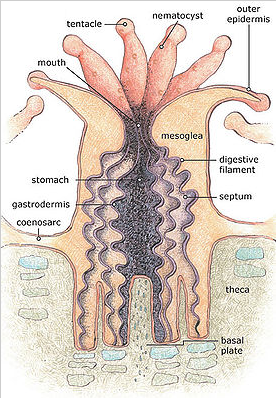http://en.wikipedia.org/wiki/File:Eusmilia_fastigiata_large.jpg
Environment
Environments for corals to survive and flourish are highly specified. Water clarity, range in temperature and salinity, and
consistent light are all important. Pristine conditions would include temperatures from 23 to 29 degrees Celsius, 32 to 42 parts per thousand [C].
consistent light are all important. Pristine conditions would include temperatures from 23 to 29 degrees Celsius, 32 to 42 parts per thousand [C].
Biology
Despite their plant like physiology, corals are comprised of individual animals called polyps. Polyps group into large colonies that are genetically identical. They are radially symmetrical and usually only a few millimeters in diameter. An exoskeleton, made of aragonite, protects the organisms from predators and harsh conditions [B].

